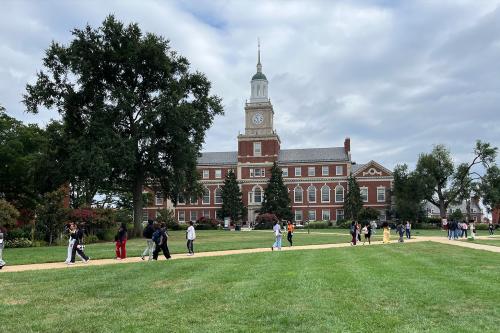WASHINGTON – In 2019, Howard University launched Howard Forward, a five-year strategic plan meant to fulfill on a bold vision of advancement in academics and operations. Using five foundational pillars as a guide, the University began conducting a strategic planning process that engages stakeholders from across the University to make strides toward Howard University’s future.
The fifth pillar of the strategic plan prioritizes the University’s efforts to Achieve Financial Sustainability. The pillar focuses on revenue diversification, process optimization, asset management, fundraising and high return investments, among other financial and efficiency related initiatives. An interdepartmental committee that includes stakeholders from Howard University’s Office of Enrollment Management, the Office of the Chief Financial Officer and Treasurer, Development and Alumni Relations and others are at the helm of efforts related to this pillar which seeks to secure the financial sustainability and viability of the University.
Enrollment and Net Tuition
One initiative under the pillar is focused on enrollment and net tuition, an area in which the University is seeing steady progress. In fact, applications for Fall 2020 have increased by 15.9 percent. Based on the more than 2,500 enrollment deposits that have been secured for the upcoming school year, Howard University administrators project an incoming freshman class size of approximately 2,000, comparable to the previous year. Additionally, more than 5,000 returning students are registered for the Fall 2020 semester, an 18% increase from the previous year. According to the Office of Enrollment Management, significant improvements in the financial aid process have led to a $1.02 million improvement in tuition payments as compared to last year.
"The prominence of the Howard education as a premier educational option continues to grow in the marketplace,” said Associate Vice President of Enrollment Management, Anthony Jones. “Enrollment Management has worked diligently to capitalize on this success through innovative ideas and dramatic process improvements. Because of the dynamic efforts of a dedicated team working in concert with the rest of the institution and alumni volunteers, the future of Howard's enrollment looks extremely bright."
The University will continue to make several administrative and process improvements in line with this initiative including hiring key enrollment management positions to increase admission conversions and compliance oversight; implementing enrollment and net tuition modeling software for more accurate strategic decision-making; and setting admissions goals for the class of 2025. Increasing alumni giving and focus on donor-funded scholarships, improving student-billing, and minimizing institutional aid refunds are other goals related to the effort.
Office of Research, Grants Management and Administration
Another important aspect of the University’s efforts to achieve financial sustainability involves improvements to Howard’s grant and contracts infrastructure. Eighteen months ago, the newly established Office of Research embarked on its systematic goals. This started with an effort to expand college and school level participation in the pursuit of grant and contract opportunities to support faculty, staff and student research. The office also created an Interoffice Research Committee (IRC), a cross-departmental group consisting of representatives from the Office of the Chief Financial Officer (CFO), the Office of the Chief Operating Officer (COO) and the Office of Human Resources (HR). The IRC acts as the central venue for multiple operating departments from across campus to collectively monitor and adopt strategies that lead to on-going improvement of grants management and administration.
“The bottom line for research at Howard University is the same as the bottom line that is embedded in our mission statement,” said Vice President of Research, Bruce Jones. “In the Office of Research, we constantly ask ourselves how we can support our schools and colleges in doing what they do best. This includes research, teaching, and being of service to the community. All of this is with the ultimate goal of improving the quality of life for people locally, nationally and around the world.”
In addition, the Office of Research has started to develop online and face-to-face training modules for faculty who are interested in joining the Howard research enterprise by learning more about how to seek out grant and contract opportunities. The Office also started developing a publication series. Research Forward: A News Bulletin is the first publication in the series and honors faculty research accomplishments and significant research related events that are sponsored by Howard University and our off-campus research partners. Finally, improvements to the Office of Research website are currently underway as the website will be critical in the ongoing drive to support and promote Howard’s research portfolio and the research expertise that is held by Howard faculty, staff and students.
Academic Program Financial Performance Review
A University is only as strong as its academic programs. To balance student success with sustainable financial management, Howard set out to create academic program financial performance reviews that track the health of its academic programs and to inform academic planning and budgets. These reviews, which will incorporate data from admissions, enrollment, staffing, and overall financial performance, can also be used to proactively identify financial opportunities and risks. The University will begin to link data between the University’s admissions, student, human resources and financial enterprise resource planning (ERP) systems and improve the quality and granularity of data in these systems to generate the reviews.
“We are very fortunate that the University is in the process of implementing a new ERP system, which is a perfect opportunity to integrate the student, human resources and financial modules to facilitate reporting,” said Assistant Vice President and Deputy Chief Financial Officer, Annemieke Martinez. “We are working closely with the ERP implementation team to further enrich the data that is in our current ERP system in support of this goal.”
The University has already hired a business intelligence analyst to support this strategic effort, and data clean-up is underway. As there is an immediate need for decision support, the University is beginning to produce static reports for each department within its 13 schools and colleges by term with the data currently available.
Reaching Historic Levels in Philanthropic Donations
Philanthropy has become a critical aspect of funding for American universities, and the strategic plan includes a comprehensive effort to increase Howard’s annual fundraising program to $50 million annually. The University is already making history with its most successful fundraising record yet, closing some of its largest gifts from living individuals in Howard history. These include the historic $10 million donation from the Karsh Family Foundation, which includes funds for the STEM Scholars program, a commitment from NBA All-Start player Stephen Curry to establish Howard’s first NCAA Division 1 golf program, and a $2.5 million gift of art from Patricia T. Walters, wife of the late Ronald W. Walters, Ph.D. who served the University as a professor and administrator for 25 years. In addition to these major gifts, the University has seen significant growth in the number of alumni making philanthropic contributions, a key priority in the strategic plan.
“This year marks a year of significant growth for philanthropy at Howard University and we are pleased to be well on our way to fulfilling our vision of revitalizing the core of our campus,” said Vice President of Development and Alumni Relations, David Bennett. “This fiscal year marks the best in Howard’s history both in terms of revenue booked and cash received. We are looking forward to engaging our alumni in this effort as we continue to expand our efforts to mirror our peer institutions.”
To learn more about the Howard Forward strategic plan, visit https://www2.howard.edu/howard-forward.
###
About Howard University
Founded in 1867, Howard University is a private, research university that is comprised of 13 schools and colleges. Students pursue studies in more than 120 areas leading to undergraduate, graduate and professional degrees. The University operates with a commitment to Excellence in Truth and Service and has produced one Schwarzman Scholar, three Marshall Scholars, four Rhodes Scholars, 11 Truman Scholars, 25 Pickering Fellows and more than 165 Fulbright recipients. Howard also produces more on-campus African-American Ph.D. recipients than any other university in the United States. For more information on Howard University, visit www.howard.edu.
Media Contact: Misha Cornelius, misha.cornelius@howard.edu




